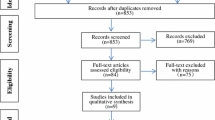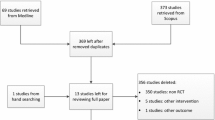Abstract
Purpose
This systematic literature review analysed the change in range of knee flexion from pre-operative values, following conventional posterior stabilised (PS) and high-flexion (H-F) PS total knee arthroplasty (TKA).
Methods
We calculated the weighted mean differences of pre- and postoperative flexion using meta-analysis with random effect modelling. Eighteen studies met our inclusion criteria. These data included a total of 2,104 PS knees that received conventional implants and 518 knees that received H-F implants.
Results
The pooled gain in flexion was 4.70° in the conventional group (p <0.0001) and 4.81° in the H-F group (p = 0.0008). In the subgroup analysis, the Western patient group showed significant difference in the gain of flexion with both implants. In contrast, no significant gain in flexion was observed in the Asian patient group.
Conclusions
These results suggest that improvement of preoperative flexion after TKA using current H-F PS prostheses is similar to that of conventional PS prostheses.




Similar content being viewed by others
References
Ritter MA, Campbell ED (1987) Effect of range of motion on the success of a total knee arthroplasty. J Arthroplasty 2:95–97
Rowe PJ, Myles CM, Walker C, Nutton R (2000) Knee joint kinematics in gait and other functional activities measured using flexible electrogoniometry: How much knee motion is sufficient for normal daily life? Gait Posture 12:143–155
Park KK, Chang CB, Kang YG, Seong SC, Kim TK (2007) Correlation of maximum flexion with clinical outcome after total knee replacement in Asian patients. J Bone Joint Surg Br 89:604–608
Nakamura S, Takagi H, Asano T, Nakagawa Y, Kobayashi M, Nakamura T (2010) Fluoroscopic and computed tomographic analysis of knee kinematics during very deep flexion after total knee arthroplasty. J Arthroplasty 25:486–491
Sultan PG, Most E, Schule S, Li G, Rubash HE (2003) Optimizing flexion after total knee arthroplasty: Advances in prosthetic design. Clin Orthop Relat Res 416:167–173
Dennis DA, Komistek RD, Scuderi GR, Zingde S (2007) Factors affecting flexion after total knee arthroplasty. Clin Orthop Relat Res 464:53–60
Li G, Schule S, Zayontz S, Maloney W, Rubash H (2003) Improving flexion in total knee arthroplasty. The adult knee, vol 2. Lippincott Williams & Wilkins, Philadelphia
Argenson JN, Komistek RD, Mahfouz M, Walker SA, Aubaniac JM, Dennis DA (2004) A high flexion total knee arthroplasty design replicates healthy knee motion. Clin Orthop Relat Res 428:174–179
Li G, Most E, Sultan PG, Schule S, Zayontz S, Park SE, Rubash HE (2004) Knee kinematics with a high-flexion posterior stabilized total knee prosthesis: An in vitro robotic experimental investigation. J Bone Joint Surg Am 86-A:1721–1729
Coughlin KM, Incavo SJ, Doohen RR, Gamada K, Banks S, Beynnon BD (2007) Kneeling kinematics after total knee arthroplasty: Anterior-posterior contact position of a standard and a high-flex tibial insert design. J Arthroplasty 22:160–165
Kim YH, Sohn KS, Kim JS (2005) Range of motion of standard and high-flexion posterior stabilized total knee prostheses. A prospective, randomized study. J Bone Joint Surg Am 87:1470–1475
Ng FY, Wong HL, Yau WP, Chiu KY, Tang WM (2008) Comparison of range of motion after standard and high-flexion posterior stabilised total knee replacement. Int Orthop 32:795–798
Nutton RW, van der Linden ML, Rowe PJ, Gaston P, Wade FA (2008) A prospective randomised double-blind study of functional outcome and range of flexion following total knee replacement with the nexgen standard and high flexion components. J Bone Joint Surg Br 90:37–42
Malik A, Salas A, Ben Ari J, Ma Y, Gonzalez Della Valle A (2010) Range of motion and function are similar in patients undergoing TKA with posterior stabilised and high-flexion inserts. Int Orthop 34(7):965–972
McCalden RW, MacDonald SJ, Bourne RB, Marr JT (2009) A randomized controlled trial comparing "high-flex" vs "standard" posterior cruciate substituting polyethylene tibial inserts in total knee arthroplasty. J Arthroplasty 24:33–38
Bin SI, Nam TS (2007) Early results of high-flex total knee arthroplasty: Comparison study at 1 year after surgery. Knee Surg Sports Traumatol Arthrosc 15:350–355
Kanekasu K, Banks SA, Honjo S, Nakata O, Kato H (2004) Fluoroscopic analysis of knee arthroplasty kinematics during deep flexion kneeling. J Arthroplasty 19:998–1003
Laskin RS (2007) The effect of a high-flex implant on postoperative flexion after primary total knee arthroplasty. Orthopedics 30:86–88
Huang HT, Su JY, Wang GJ (2005) The early results of high-flex total knee arthroplasty: A minimum of 2 years of follow-up. J Arthroplasty 20:674–679
Weeden SH, Schmidt R (2007) A randomized, prospective study of primary total knee components designed for increased flexion. J Arthroplasty 22:349–352
Murphy M, Journeaux S, Russell T (2009) High-flexion total knee arthroplasty: A systematic review. Int Orthop 33:887–893
Gandhi R, Tso P, Davey JR, Mahomed NN (2009) High-flexion implants in primary total knee arthroplasty: A meta-analysis. Knee 16:14–17
Coleman BD, Khan KM, Maffulli N, Cook JL, Wark JD (2000) Studies of surgical outcome after patellar tendinopathy: Clinical significance of methodological deficiencies and guidelines for future studies. Victorian Institute of Sport Tendon study group. Scand J Med Sci Sports 10:2–11
Altman DG, Schulz KF, Moher D, Egger M, Davidoff F, Elbourne D, Gotzsche PC, Lang T (2001) The revised consort statement for reporting randomized trials: Explanation and elaboration. Ann Intern Med 134:663–694
Khanna A, Gougoulias N, Longo UG, Maffulli N (2009) Minimally invasive total knee arthroplasty: A systematic review. Orthop Clin North Am 40:479–489
Parsley BS, Conditt MA, Bertolusso R, Noble PC (2006) Posterior cruciate ligament substitution is not essential for excellent postoperative outcomes in total knee arthroplasty. J Arthroplasty 21:127–131
Gioe TJ, Glynn J, Sembrano J, Suthers K, Santos ER, Singh J (2009) Mobile and fixed-bearing (all-polyethylene tibial component) total knee arthroplasty designs. A prospective randomized trial. J Bone Joint Surg Am 91:2104–2112
Cheng K, Ridley D, Bird J, McLeod G (2010) Patients with fixed flexion deformity after total knee arthroplasty do just as well as those without: Ten-year prospective data. Int Orthop 34:663–667
McCalden RW, MacDonald SJ, Charron KD, Bourne RB, Naudie DD (2010) The role of polyethylene design on postoperative TKA flexion: An analysis of 1534 cases. Clin Orthop Relat Res 468:108–114
Chaudhary R, Beaupre LA, Johnston DW (2008) Knee range of motion during the first two years after use of posterior cruciate-stabilizing or posterior cruciate-retaining total knee prostheses. A randomized clinical trial. J Bone Joint Surg Am 90:2579–2586
Tanzer M, Smith K, Burnett S (2002) Posterior-stabilized versus cruciate-retaining total knee arthroplasty: Balancing the gap. J Arthroplasty 17:813–819
Wohlrab D, Hube R, Zeh A, Hein W (2009) Clinical and radiological results of high flex total knee arthroplasty: A 5 year follow-up. Arch Orthop Trauma Surg 129:21–24
Victor J, Banks S, Bellemans J (2005) Kinematics of posterior cruciate ligament-retaining and -substituting total knee arthroplasty: A prospective randomised outcome study. J Bone Joint Surg Br 87:646–655
Zeh A, Davis J, Laskin R, Klima S, Wohlrab D (2009) Early results with the Genesis II Posterior Stabilized High Flexion knee prosthesis. A one year follow-up study. Acta Orthop Belg 75:792–800
Maruyama S, Yoshiya S, Matsui N, Kuroda R, Kurosaka M (2004) Functional comparison of posterior cruciate-retaining versus posterior stabilized total knee arthroplasty. J Arthroplasty 19:349–353
Hasegawa M, Sudo A, Uchida A (2009) Staged bilateral mobile-bearing and fixed-bearing total knee arthroplasty in the same patients: A prospective comparison of a posterior-stabilized prosthesis. Knee Surg Sports Traumatol Arthrosc 17:237–243
Watanabe T, Muneta T, Ishizuki M (2009) Is a minimally invasive approach superior to a conventional approach for total knee arthroplasty? Early outcome and 2- to 4-year follow-up. J Orthop Sci 14:589–595
Maloney WJ, Schurman DJ (1992) The effects of implant design on range of motion after total knee arthroplasty. Total condylar versus posterior stabilized total condylar designs. Clin Orthop Relat Res 278:147–152
Bozic KJ, Kinder J, Meneghini RM, Zurakowski D, Rosenberg AG, Galante JO (2005) Implant survivorship and complication rates after total knee arthroplasty with a third-generation cemented system: 5 to 8 years followup. Clin Orthop Relat Res 430:117–124
W-Dahl A, Robertsson O, Lidgren L (2010) Surgery for knee osteoarthritis in younger patients. Acta Orthop 81:161–164
Schurman DJ, Rojer DE (2005) Total knee arthroplasty: Range of motion across five systems. Clin Orthop Relat Res 430:132–137
Ahmed I, Gray AC, van der Linden M, Nutton R (2009) Range of flexion after primary tka: The effect of soft tissue release and implant design. Orthopedics 32:811
Ranawat CS (2003) Design may be counterproductive for optimizing flexion after TKR. Clin Orthop Relat Res 416:174–176
Nagura T, Dyrby CO, Alexander EJ, Andriacchi TP (2002) Mechanical loads at the knee joint during deep flexion. J Orthop Res 20:881–886
Han HS, Kang SB, Yoon KS (2007) High incidence of loosening of the femoral component in legacy posterior stabilised-flex total knee replacement. J Bone Joint Surg Br 89:1457–1461
Sharma A, Komistek RD, Scuderi GR, Cates HE Jr (2007) High-flexion TKA designs: What are their in vivo contact mechanics? Clin Orthop Relat Res 464:117–126
Moynihan AL, Varadarajan KM, Hanson GR, Park SE, Nha KW, Suggs JF, Johnson T, Li G (2010) In vivo knee kinematics during high flexion after a posterior-substituting total knee arthroplasty. Int Orthop 34:497–503
Nakayama K, Matsuda S, Miura H, Iwamoto Y, Higaki H, Otsuka K (2005) Contact stress at the post-cam mechanism in posterior-stabilised total knee arthroplasty. J Bone Joint Surg Br 87:483–488
Edwards JZ, Greene KA, Davis RS, Kovacik MW, Noe DA, Askew MJ (2004) Measuring flexion in knee arthroplasty patients. J Arthroplasty 19:369–372
Ritter MA, Harty LD, Davis KE, Meding JB, Berend ME (2003) Predicting range of motion after total knee arthroplasty. Clustering, log-linear regression, and regression tree analysis. J Bone Joint Surg Am 85-A:127–1285
Conflict of interest
The authors have no conflicts of interests.
Author information
Authors and Affiliations
Corresponding author
Rights and permissions
About this article
Cite this article
Sumino, T., Gadikota, H.R., Varadarajan, K.M. et al. Do high flexion posterior stabilised total knee arthroplasty designs increase knee flexion? A meta analysis. International Orthopaedics (SICOT) 35, 1309–1319 (2011). https://doi.org/10.1007/s00264-011-1228-4
Received:
Accepted:
Published:
Issue Date:
DOI: https://doi.org/10.1007/s00264-011-1228-4




